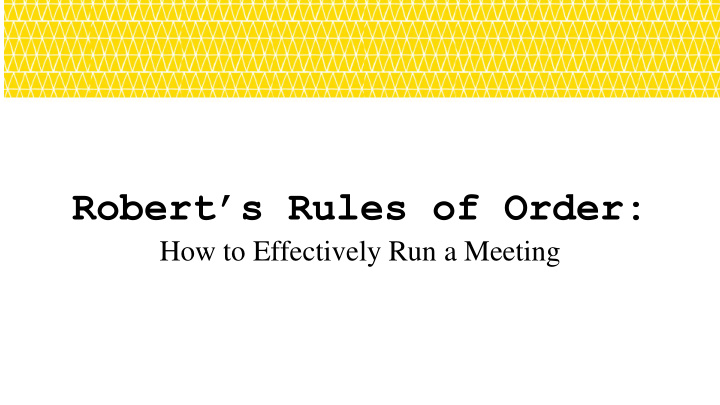



Robert’s Rules of Order: How to Effectively Run a Meeting
What is Robert’s Rules of Order? • Most widely used manual of “parliamentary procedure” for non -legislative organizations • Used as a means to organize a meeting for: • Church groups • Professional societies • School boards • Associations • Etc.
Purpose of Robert’s Rules of Order • Ensure “majority rule” • Protect rights of minority & absentee votes • Provide order and fairness in decisions made • Expedite meetings • All members have equal rights and privilege • Provides checks and balances amongst hierarchy of positions in meetings
Components of Robert’s Rules of Order • Quorum must be present for business to occur. Quorum is the minimum number of members of a group that must be present at any meeting, to ensure that enough voices are heard for the decisions made during that meeting to be valid • Agenda created for meeting • Motions – formal proposal for action to be taken on certain topic by organization’s membership
Let’s Put It All Together…
Commonly Asked Questions of Robert’s Rules of Order 1. Is it true that the president can vote only to break a tie? a) No, it is not true. If the president is a member of the voting body, he or she has exactly the same rights and privileges as all other members have, including the right to make motions, to speak in debate, and to vote on all questions.. However, the impartiality required of the presiding officer of any other type of assembly (especially a large one) precludes exercising the rights to make motions or speak in debate while presiding, and also requires refraining from voting except (i) when the vote is by ballot, or (ii) whenever his or her vote will affect the result. Adapted from: The Official Robert’s Rules of Order Website
Commonly Asked Questions of Robert’s Rules of Order 2. Can an ex-officio member vote and are they counted in determining whether a quorum is present? a) “Ex officio” is a Latin term meaning “by virtue of office or position.” Ex -officio members of boards and committees, therefore, are persons who are members by virtue of some other office or position that they hold, including the right to vote. There are, however, two instances in which ex-officio members are not counted in determining the number required for a quorum or in determining whether or not a quorum is present: 1) In the case of the president, whenever the bylaws provide that the president shall be an ex- officio member of all committees (or of all committees with certain stated exceptions); and 2) When the ex-officio member of the board or committee is neither an ex-officio officer of the board or committee nor a member, employee, or elected or appointed officer of the society (for example, when the governor of a state is made ex officio a member of a private college board). Adapted from: The Official Robert’s Rules of Order Website
Commonly Asked Questions of Robert’s Rules of Order 3. In determining the result of a vote, what constitutes a majority? a) The word “majority” in this context means, simply, more than half voted in favor. Please note that abstentions always fall to the negative vote. For example, if 9 votes were casted, 4 voted in favor, 4 voted opposed, and there was one abstention, the vote would fail as more than 50 percent voted in the negative. Adapted from: The Official Robert’s Rules of Order Website
Commonly Asked Questions of Robert’s Rules of Order 4. How can I get an item on the agenda for a meeting? a) For a proposed agenda to become the official agenda for a meeting, it must be adopted by the assembly at the outset of the meeting. At the time that an agenda is presented for adoption, it is in order for any member to move to amend the proposed agenda by adding any item that the member desires to add, or by proposing any other change. b) It is wrong to assume, as many do, that the president “sets the agenda.” It is common for the president to prepare a proposed agenda, but that becomes binding only if it is adopted by the full assembly, perhaps after amendments as just described. Adapted from: The Official Robert’s Rules of Order Website
Robert’s Rule of Order: Cheat Sheet
Recommend
More recommend